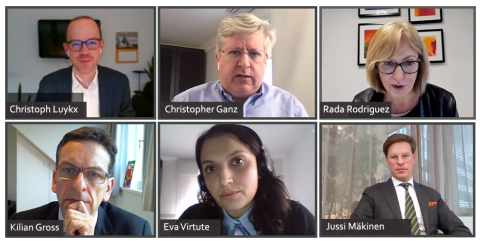Industrial AI: what future regulatory blueprint?
4 December 2020

How to ensure that the upcoming EU AI legislation achieves its objective of being an enabler of European excellence in AI and not an obstacle? This was the focus of Orgalim’s last Industrial Strategy in Focus event on 2 December, a year to the day since our first event on AI policy. The roundtable, moderated by Orgalim’s Policy Director Christoph Luykx, brought together stakeholders from the Commission and industry for an in-depth discussion that yielded timely insights into the legislation being drafted and the key challenges involved particularly when it comes to industrial AI.
Opening the proceedings, Orgalim President Rada Rodriguez pointed out that Europe’s technology industry is already an experienced leader in industrial AI applications and its technologies are very often horizontal, enabling the development of many other industrial sectors. So the upcoming legislation will have a very big impact on Europe’s manufacturing industries and their ability to remain globally competitive. She highlighted two key questions: one, how to frame the scope of the legislation when there is such a difference between, broadly, B2C and B2B AI, and secondly, how to ensure integration with existing legislation, like the Machinery Directive. "AI is not one thing that can be tackled or regulated uniformly," she stressed. "We need to distinguish clearly, for example, between low-risk AI being operated in a closed environment and high-risk AI that might have an impact on customers."
Jussi Mäkinen, Head of Digital Regulation, Technology Industries of Finland, and the Chair of Orgalim’s AI Task Force, pointed out that the existing regulatory landscape consists mostly of technology-neutral pieces of legislation. Developing a technology-specific piece of legislation, that requires not only defining AI itself but also defining high-risk AI, "is a very great challenge indeed." Industrial AI expert Christopher Ganz agreed and advised taking a more general risk-based approach, rather than trying to tie the regulation too closely to a technology.
We think that a lot of AI use, like predictive maintenance or optimisation of production processes, which is not human-related, is probably not risky at all and doesn’t need any additional requirements.
On the question of integration with existing legislation, Eva Virtute, Associations Manager at KION Group, emphasised that the existing legislation has repeatedly proven itself fit for purpose and that industry has thousands of use cases it can contribute. She also stressed the important role that technology standards are playing and can play. "It is very important for European industries to have the support of European institutions in promoting the development of standards regarding AI technologies, which will also help Europe to compete internationally," she said.
Taking on board all these points, Mr Gross emphasised in closing that the AI legislation should be proportionate and pragmatic, so that it is not an obstacle but an enabler, helping to make sure that all AI is trusted. He welcomed more open exchanges with stakeholders such as this one and said the Commission is aiming to publish the draft legislation towards the end of the first quarter next year.
In case you missed the event, you can access the full recording here.

LATEST NEWS
How can we create a dynamic, competitive European high-tech manufacturing base?
Orgalim's key recommendations offer policymake...
